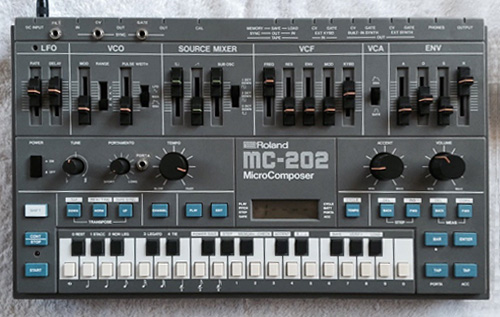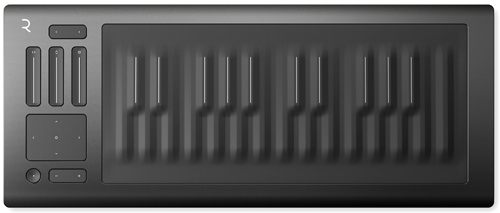Anyone who has ever heard his Risveglio or SONOIO albums can tell you, Alessandro Cortini is an accomplished electronic composer. But as a 14-year-old in Italy, he spent most of his time shredding on an Ibanez JEM. That led him to Musicians Institute in Los Angeles, where he ultimately focused on keyboards, and eventually to joining Nine Inch Nails.
After touring heavily with NIN last year, Cortini is back in Los Angeles and preparing for a solo show. “It’s on the first day of the year, at a club in Berlin called Berghain,” Cortini says. “I’ll be doing an ambient set for anyone who has recovered from celebrating the night before.”
Cortini took time out to speak with Reverb about his favorite EMS Synthi AKS and VCS3 synths, guitar preferences, his creative process, and working with Trent Reznor.
When did you switch your focus from guitar to keys?
Alessandro Cortini: After playing guitar with The Mayfield Four, I went back to LA, saw a flyer for a NIN audition, went, and got the job. So I never really changed to synths, the gig just required it. Keyboard duties were about learning lines, playing in time, and knowing the changes. Piano was usually handled by Trent. The day I got the gig I figured out what middle C was.
Did you have any keyboard background at all?
I’d compose parts in Logic, using soft synths, like Steinberg’s Model E. Sometimes it’s nice to use an instrument you don’t know the rules of. Then I brought my cousin’s Minimoog back from Italy, and things changed. Sure, the sounds are fantastic, but mainly it was the hands-on experience. That doesn’t happen with software. I loved the fact that it was old, which connected me to it. I would stick a pencil under the key, to keep the note on, and then play with the knobs.
Seems like you were cut out for modular all along then!
Eventually, at Musician’s Institute, I taught synthesis to kids, many of whom didn’t give a shit. After doing that for 35 hours each week, the last thing I wanted to do was use a computer when I was working on my own music. I bought a used Analogue Systems modular online, and that was the beginning. Two years later, at the NIN audition, Trent and I had a lot to talk about it because we had that in common.
What systems did you work with next?
Buchla really spoke to me early on. It was weird in the right way. Don [Buchla], taught me about the deeper meaning of the instrument. It became an obsession. I loved tracking down a machine as old as me, with quirks just like any person. Making music on one is like being an explorer in uncharted territory. Sometimes it’s less about the quality of the music you’re making, and more about finding out what the machine has to say to you that you haven’t heard before. I did the Forse series on one.
How do you feel about the recent flood of Eurorack modules that have become available?
Some are good, but some do too many things. Richard Devine once showed me a single module that did so much it gave me the same anxiety I’d have if had to evacuate an airplane. They are made by talented designers, but I’m not inspired when I connect from the output of a single module and it already sounds like a patch. Richard is amazing with anything, though. You could lock him in a room with a spoon, a plastic dinosaur, and a light bulb and he could make a record out of it. I’m very fond of people who have spent a lot of time with complete modular systems. Tony and Kelly at Make Noise think of their Shared System is one instrument. Mark Verbos, Harvestman, Live Wire - those builders think the same way. I don’t have a Eurorack system that’s a collection of modules by different builders for that reason. If you’re you’re actually excited about the interaction of the sympathetic components, and the process, that will lead you to an idea, which can develop.
When you’re in a rut, do you have as a go-to system?
I keep going back to EMS Synthi AKS and VCS3. If I had to be stuck on an island with one machine it would be my Synthi AKS. Among other modifications, mine has Mk I outputs even though it’s a MK II. It was hot rodded by Constantin Papageorgiadis, who lives in Belgium. It’s a Muscle Synthi!
With so many different synths being used to make the records, do you have a problem recreating it live?
Trent has always allowed me carte blanche, as long as it fits within the NIN idea. He lets me choose how I get there. When preparing for a tour, I try to recreate the melodic content, one way or another, but I also come up with ideas that will be fun, night after night. I feel lucky because I can’t think of any time I didn’t have Trent’s support. Every tour the gear changes so, as a result, we deal with the songs in a different way. On the last tour, along with the keyboards, and modulars, I had an [Elektron] Octatrack, a TB303, a Nagra tape machine, an old four track… it was fucking crazy [laughs].
What did you do with the four track?
It was for drones and replicating keyboard parts. I recorded the four chords of “Hurt,” putting one on each track. Live, I’d bring up the fader of each chord, following the changes of the music.
Like 10cc did with “I’m Not In Love?”
Yes. It worked so well, I decided to use it on the other songs. So my set list became a rack of cassettes in front of me, laid out in order. I love having EQ control of each track. If I need more low end on a drone, no problem. Want to pan left or right? Just turn the knob. It’s very hands-on that way. I can introduce it into any song depending on what’s called for on a given night.
How do you meet challenges when it’s just you, performing your solo music?

Roland MC-202
The Sonno record was done with a Roland MC-202, which has no memory so, for live performances, you have to introduce a laptop to do that via MIDI: USB to CV to the 202. Plus I’d need to use that computer to synch video from Logic. All of this puts a laptop on stage, which I fucking hate. So in order to travel on my own, and have a reliable set up, I recorded the output of the 202 as an audio file, all filters open. That became the audio track of my live visuals, which I played back as a movie, from my iPad. It’s no different than if the MC202 was handling the playback, triggered by a computer, but now I don’t have to bring those on tour anymore. If the shit hits the fan I want to be able to go into a store and buy what I need. If the 202 breaks, I can’t just go do that. If the iPad breaks, I have an app on my phone, plus my set is stored on DropBox. I learned from playing in NIN that paranoia can be good because it encourages you to have a redundant plan. The audio of that movie routes through filters, envelopes, a Strymon DECO, a Strymon Timeline, or Dig, an Industrialectric Echo Degrader, a Way Huge Supa-Puss, which is one of my favorite delays ever, a Strymon Blue Sky, a Mr Black Eterna Gold, and an RML Fuzz. I can introduce the creative process to each show in different ways. I don’t just press play. One night it’s quiet and reverby, the next, in your face and distorted.
There’s a lot of focus on analog, these days, but you use a lot of digital gear.

ROLI Seaboard RISE
I love the Teenage Engineering OP-1. The Korg Prophecy, and Waldorfs are amazing. The Nord Lead 2 is incredible and it’s virtual analog. The Nord Modular is weird, glassy, and awesome. The ROLI Seaboard RISE’s hardware is great, but only half the story. The way it integrates with the software is amazing. In a half hour I was already making patches that I play live on the Swarmatron, which is a rare, hand built instrument. The ideal instrument is one you get into so deeply that you don’t care about how it’s making sound, you just bring what you have to it, and it can become yours. Neil Degrasse Tyson once gave an example of people having an amazing meal, and asking the chef “what’s your secret?” - as if there was one thing that makes the chef cook a particular way. The way we play music, look, and think is the sum of many events in our lives. So I’m going to use an instrument uniquely, not because I’m better, but because there’s only one me, just like there’s only one you, and you’re the sum of your experiences.
You mentioned you’ve been playing a lot more guitar lately.
I’ve been selling some old synths I don’t use anymore, and getting back into the passion I had when I was 14. I’ve been playing my ‘61 Jazzmaster, and my Custom Shop Telemaster, loaded with P-90’s, that I bought used. It’s funny, I want shredding guitars to look perfect (laughs), but I love that these two guitars are worn. This time around it’s less about how many notes I can play and more to do with what makes it sound interesting: chords, patterns, effects. Essentially like what I do with synths, only on guitar.
Do you have a favorite amp?
I have a Princeton Silverface reissue. I also use a Big Trees by Audio Kitchen. It has two outputs, so it can be used in line, like a distortion pedal, or as [2.5 watt] amp itself. I’ll connect it directly to the speaker sometimes, or just use it like a stompbox. It uses a couple of tubes, sounds like a refined Marshall, and the box is painted by his daughter. Each one is different. Mine has a stick figure the owner of the company, Steve, and me on it. I first saw (producer) Alan Moulder using one. That and the Princeton give me versatility. I prefer amp distortion over pedals, so this takes care of that.
Modern Electronic Production Gear